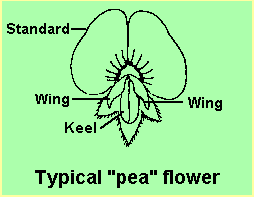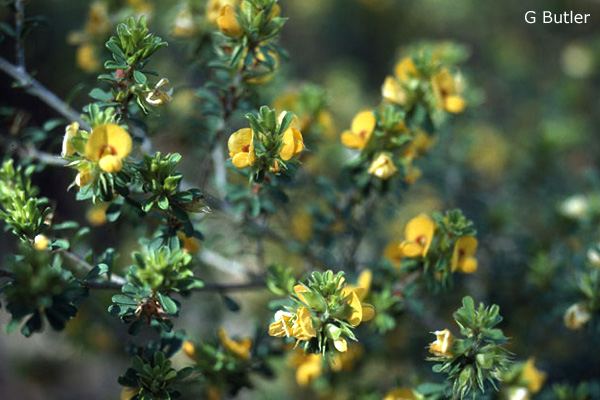General Description:
The genus Pultenaea consists of around 120 species, all of which are Australian endemics and which can be found in all states and territories. All are small to medium shrubs commonly referred to as “bush peas”. Together with some related genera such as Dillwynia and Phyllota they are also referred to as “eggs and bacon”, a reference to the yellow flowers with red markings.
Pultenaea parviflora is a small, bushy shrub to about 1 metre in height. The small leaves are oval-shaped to about 5 mm long, arranged alternately on the stems.

The flowers of have the typical “pea” shape consisting of 4 petals; the “standard”, the “keel” and two “wings”, as shown in the diagram. The flowers are longer than they are wide (about 10 mm long by 7 mmm across), which is typical of most species in the genus. Flowering is mainly in spring but it may extend into summer. The flowers are followed by small seed pods.
P.parviflora is occasionally grown by enthusiasts but is not in wide cultivation. It is suited to well drained soils in a sunny or semi-shaded position. It is tolerant of at least moderate frost.
Propagation is easy from seed following pre-treatment to break the physical dormancy provided by the impervious seed coat. Pre-treatment can be carried out by abrasion or by the use of boiling water (further details can be found in under the “Propagation” tab of the “Pea Family” page). The seed retains viability for many years. Cuttings strike well using firm, current season’s growth, however, constant misting should be avoided as the hairy foliage tends to hold water and rotting may occur.
* EPBC Act = Environment Protection and Biodiversity Conservation Act 1999;
ROTAP = Rare or Threatened Australian Plants (Briggs and Leigh, 1988)
For further information refer the Australian Plants at Risk page

Pultenaea parviflora
Photo: Geoff Butler – Australian National Botanic Gardens
 Australian Native Plants Society (Australia)
Australian Native Plants Society (Australia)